Explore Sapa - North Vietnam Travel, Asia
Nestled in the majestic mountains of Northern Vietnam, Sapa is a captivating destination that enchants visitors with its breathtaking landscapes and dynamic cultural heritage. Known for its terraced rice fields, towering peaks, and diverse ethnic communities, Sapa offers a unique blend of natural beauty and rich cultural heritage. Whether you're an adventure seeker, a cultural enthusiast, or simply looking for a tranquil escape, Sapa has something to offer everyone.
Check out all our tours to Vietnam here.
Population: Approximately 70,000 in 2022.
Economy: Emerges from a poor agricultural area to one of the top choices for tourism in Vietnam, resulting in many local development programs which help raise living standards in Sapa.
Landmarks: Famous for Fansipan Mountain, Muong Hoa Valley, and Cat Cat Village.
Vietnam
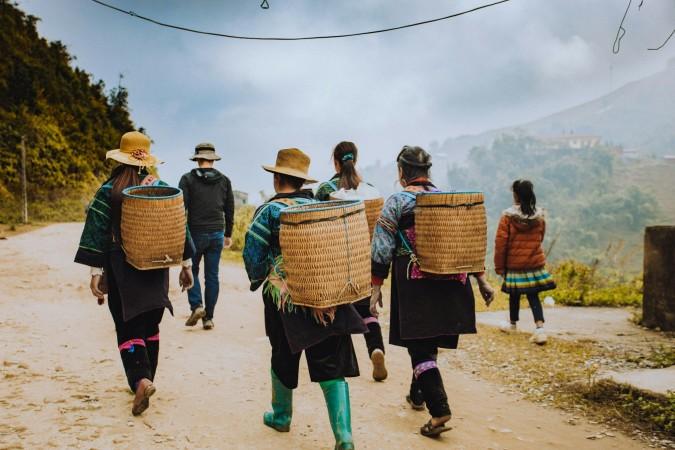
Overview of Sapa
History & Cultural Influence
The town was established as a hill station by the French in the early 20th century, and remnants of French colonial architecture still dot the area. This unique cultural fusion is the result of the seamless integration of European influence with the local indigenous civilizations. However, the true soul of Sapa lies in its ethnic minority groups, including the Hmong, Dao, and Tay people. Their rich cultural past is evident in the colorful traditional attire, dexterous needlework, and handmade fabrics you find in the marketplaces. Exploring Sapa's villages offers a window into the daily lives and customs of these diverse communities, making it a cultural experience like no other.
Interaction with the Locals
Sapa, a picturesque town in Northern Vietnam, is home to a diverse population of approximately 70,000 people. The region is renowned for its vibrant ethnic communities, including the Hmong, Dao, Tay, and Giay people. These groups preserve the distinct cultural traditions, languages, and lifestyles, contributing to the rich cultural tapestry of Sapa. The locals are known for their warm hospitality and vibrant traditional attire, often seen in the bustling markets and colorful festivals. Sapa is an interesting place for those looking for a genuine experience because of its cultural richness.
If you love to blend in with the ethnic groups in Vietnam, check out our article about Dak Lak here.
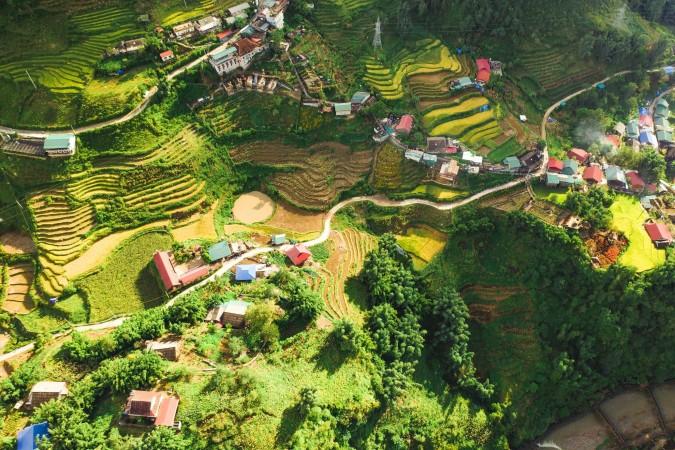
Village in Sapa - © Krisztian Tabori
Top Attractions in Sapa
Sapa boasts a wealth of attractions that cater to every type of traveler, from nature lovers to culture enthusiasts. These must-visit spots in Sapa highlight the region's natural beauty, rich cultural heritage, and diverse experiences. Whether you're hiking the highest peaks or exploring traditional villages, Sapa offers an unforgettable journey into the heart of Northern Vietnam.
Fansipan Mountain
Located in Vietnam, Fansipan Mountain is the highest mountain in the country. Commonly referred to as the "Roof of Indochina," its highest peak stands at 3,143 meters high. Adventurous travelers can embark on a challenging trek to the summit, where they'll be rewarded with stunning panoramic views of the surrounding mountains and valleys. For a more relaxed experience, the cable car ride offers a breathtaking aerial perspective of the lush landscapes below.
Muong Hoa Valley
Renowned for its expansive terraced rice fields, Muong Hoa Valley is a picturesque destination that draws photographers and trekkers alike. The valley is peppered with ethnic minority communities where tourists may learn about the distinctive cultural history of the area and observe traditional farming methods. The Muong Hoa River, which flows through the valley, adds to the serene beauty of the landscape.
Cat Cat Village
Located just a short walk from Sapa town, Cat Cat Village is a traditional Hmong village that offers a glimpse into the daily life of the local people. The community is well-known for its charming waterfall, classic wooden homes, and lively marketplaces for handicrafts. Visitors can watch local artisans at work and purchase handmade textiles, jewelry, and souvenirs.
Sapa Stone Church
A remnant of French colonial architecture, the Sapa Stone Church is a historic landmark in the heart of Sapa town. Built in the early 20th century, the church features Gothic architectural elements and stands as a symbol of the town's colonial past. The church is a popular spot for tourists, offering a peaceful setting and stunning views of the surrounding mountains.
Sapa Market
A bustling hub of activity, Sapa Market is where locals and tourists alike come to shop for fresh produce, local delicacies, and handmade crafts. The market is an excellent place to experience the vibrant atmosphere of Sapa and to sample traditional foods and snacks. It’s also a great spot to buy unique souvenirs, such as handwoven textiles and silver jewelry.
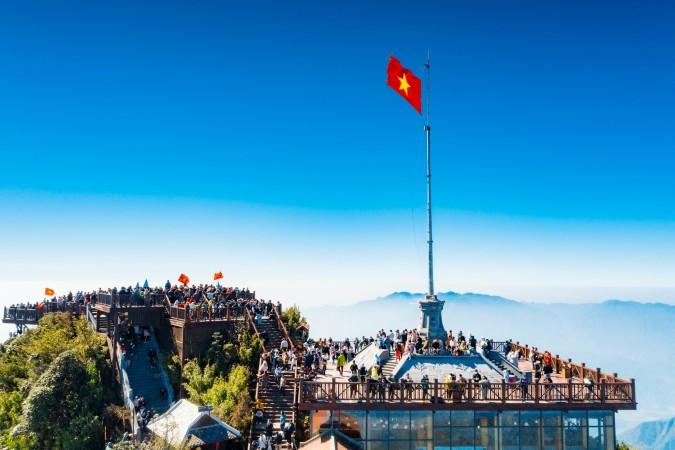
Highest peak of Fansipan Mountain - © Vivu Vietnam
Must-Try Dishes in Sapa
Sapa’s local cuisine is a lovely representation of the city's distinctive climate and rich cultural variety. These regional cuisines from Sapa offer a varied and interesting gastronomic experience that highlights the distinctive tastes and customs of the region. Whether you're enjoying a hearty stew or a simple serving of bamboo sticky rice, the food in Sapa offers a delicious journey into the heart of Northern Vietnam's culture and cuisine.
- Thang Co: A traditional dish of the Hmong people, Thang Co is a hearty stew made with horse meat, bones, and internal organs, flavored with a mix of special herbs and spices. This dish is often served during festivals and communal gatherings, offering a taste of local culture and tradition.
- Salmon Hot Pot: Because of Sapa's temperate environment, salmon can be farmed there, leading to the local specialty of salmon hotpot. This recipe calls for fresh salmon to be cooked in a savory broth along with a variety of vegetables, mushrooms, and herbs.
- Bamboo Sticky Rice (Com Lam): A straightforward yet tasty meal called "com lam" is produced by cooking sticky rice with bamboo tubes. The bamboo imparts a unique smoky flavor to the rice, which is often served with grilled meats or vegetables. This dish is a staple among the local ethnic minorities and is a must-try for visitors.
- Seven-Colored Sticky Rice (Xoi Bay Mau): A specialty of the Nung and Tay ethnic groups, this dish features sticky rice colored with natural plant dyes in seven different shades. Each color is believed to represent a different aspect of life, making it a dish rich in cultural significance.
- Sapa "Cap Nach" Pork: This dish features pork from a local breed of small pigs that are typically raised in the mountains. The pork is tender and flavorful, often grilled or roasted to perfection. It's commonly served with a variety of herbs and dipping sauces, offering a true taste of Sapa's unique culinary traditions.
- Corn Wine (Ruou Ngo): No culinary tour of Sapa is complete without sampling the local corn wine. This traditional alcoholic beverage is made from fermented corn and is a staple at local celebrations and festivals.
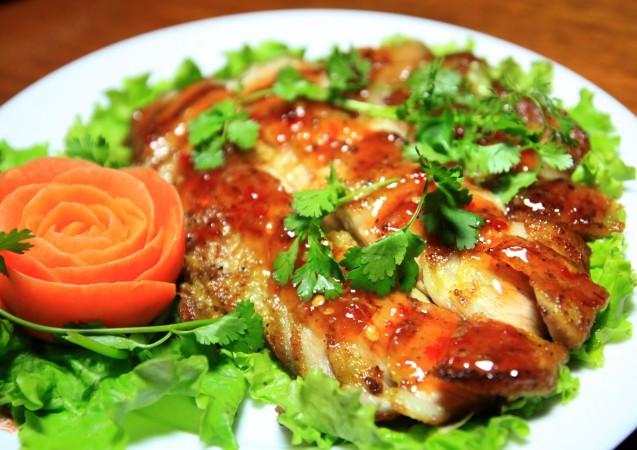
Sapa "Cap Nach" Pork - © MIA
Festivals & Local Celebrations
Sapa is a vibrant hub of cultural festivities and traditional celebrations, offering visitors a unique glimpse into the customs and traditions of the local ethnic communities.
Love Market Gathering
The Love Market of Sapa is a unique cultural event that takes place on Saturday evenings. Originally, it was a place for young men and women from the surrounding villages to meet and court each other. Today, while the romantic aspect has faded, the market still features traditional music, dance performances, and local handicrafts, offering visitors a lively and colorful experience.
Gau Tao Festival
The Hmong people celebrate the Gau Tao Festival, a colorful New Year's event that usually takes place in January or February. The festival is filled with traditional games, folk music, dance, and rituals to pray for good health and a prosperous year. It's a joyous occasion where locals and visitors alike can participate and enjoy the rich cultural heritage of the region.
Roong Pooc Festival
Also known as the Spring Festival, Roong Pooc is celebrated by the Tay and Giay communities. The celebration, which takes place in February or March, heralds the end of winter and the start of farming season. It includes a variety of cultural activities such as traditional singing, dancing, and a buffalo sacrifice ceremony, believed to bring good fortune for the coming year.
Tet Holiday (Lunar New Year)
Like the rest of Vietnam, Sapa celebrates Tet, the Lunar New Year, with great enthusiasm. During this time, families gather to honor their ancestors and welcome the new year with traditional foods, decorations, and cultural performances. The streets and markets of Sapa are adorned with colorful flowers and lanterns, creating a festive and joyous atmosphere.
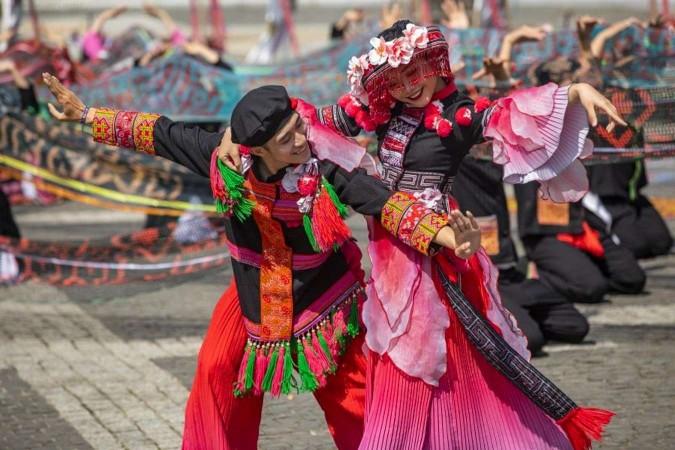
Sapa Love Market - © Vietnam Law News
What to Do in Sapa
Sapa offers a wide range of activities for visitors, catering to all interests and adventure levels. Here are some popular tourist activities you shouldn’t miss:
Trekking in Sapa
Trekking and hiking paths in Sapa are well known for their spectacular vistas of towering mountains, verdant valleys, and terraced rice farms. Popular treks include routes to Fansipan Mountain, the Muong Hoa Valley, and ethnic minority villages like Cat Cat, Ta Van, and Ta Phin. These treks range from easy to challenging, providing opportunities for both casual hikers and seasoned adventurers.
Homestay Experiences
One excellent method to fully immerse oneself in the local culture is to stay in a homestay. Many ethnic minority families offer accommodations in their homes, providing a unique opportunity to experience daily life, enjoy traditional meals, and learn about local customs and crafts. This encounter promotes community-based tourism and facilitates meaningful cross-cultural interaction.
Explore Sapa Markets
Exploring Sapa's local markets is a must-do activity. These markets are vibrant with the sights and sounds of local life, offering everything from fresh produce and traditional foods to handmade textiles and crafts. The markets are a great place to shop for souvenirs, try local delicacies, and interact with the friendly locals.
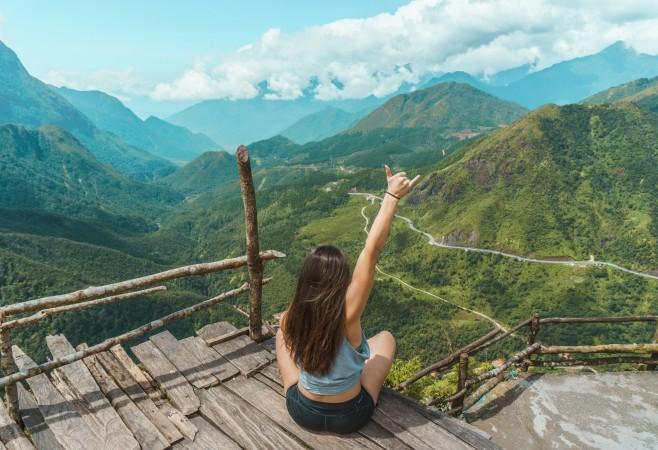
Trekking Route in Sapa - © Darren Lawrence
Shopping in Sapa
Sapa's local markets and shops offer a rich variety of local products, making it a paradise for shoppers interested in unique and traditional items. Here’s a list of what to buy in Sapa for souvenir and gifting purposes:
Handwoven Textiles
The ethnic minority communities in Sapa are known for their exquisite handwoven textiles. You can find beautifully embroidered clothing, scarves, and bags, often made using traditional techniques passed down through generations. Every artwork is distinct and conveys a tale about the cultural history of the area.
Silver Jewelry
Sapa is famous for its handcrafted silver jewelry, particularly pieces made by the Hmong people. The jewelry often features intricate designs and motifs inspired by nature and local traditions. These accessories, which range from necklaces and rings to bracelets and earrings, are exquisite and heartfelt keepsakes.
Local Handicrafts
In addition to textiles and jewelry, Sapa's markets offer a range of local handicrafts, including wooden carvings, pottery, and bamboo items. These crafts reflect the creativity and skill of the local artisans and are perfect for bringing a piece of Sapa's culture home with you.
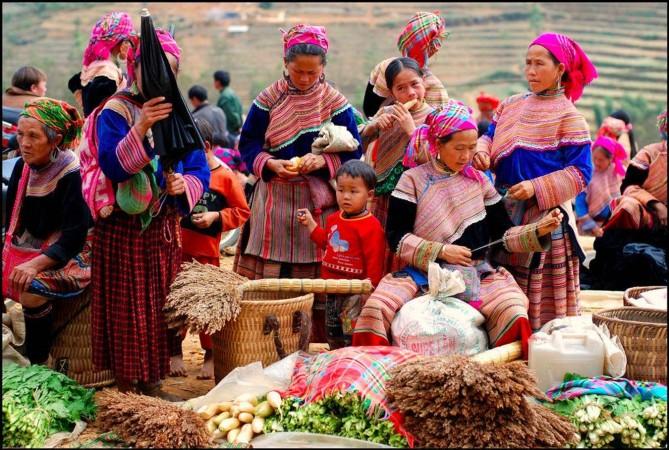
Traditional Sapa's market - © ToQuoc
Weather in Sapa: Best Time to Visit
Sapa is known for its cool, temperate climate, making it a refreshing escape from the typically hot and humid weather of other parts of Vietnam. The town experiences four distinct seasons, each offering a unique experience for visitors.
Spring in Sapa
Spring is one of the best times to visit Sapa, with mild temperatures and blooming flowers from 15°C to 20°C (59°F to 68°F). Travelers are lured to the lovely weather and spectacular landscape of the terraced rice fields in the spring, which creates an incredibly picturesque image. The weather is perfect for trekking and exploring the natural beauty of the region.
Summer in Sapa
Summer in Sapa is warm and rainy, ranging from 18°C to 25°C (64°F to 77°F) with frequent afternoon showers. The rains keep the landscape vibrant and green, and the waterfalls are at their most impressive. While the weather can be unpredictable, summer is a great time to experience Sapa's lush scenery and enjoy cooler temperatures compared to other parts of Vietnam.
Autumn in Sapa
Autumn is another excellent time to visit Sapa, with clear skies and cooler temperatures from 12°C to 20°C (54°F to 68°F). The weather is generally dry and clear, with cool, crisp air, marked by the golden hues of the rice fields as they reach harvest time, creating stunning landscapes. This season is a peak season for tourism in Sapa. The crisp, fresh air and beautiful landscapes make autumn a favorite time for photographers and trekkers.
Winter in Sapa
Winter in Sapa can be cold, with temperatures occasionally dropping below freezing from about 5°C to 15°C (41°F to 59°F). The town can even experience snowfall, creating a picturesque winter wonderland. Winter provides a different and tranquil experience, with fewer people and calm surroundings, yet the cold may put off some travelers.
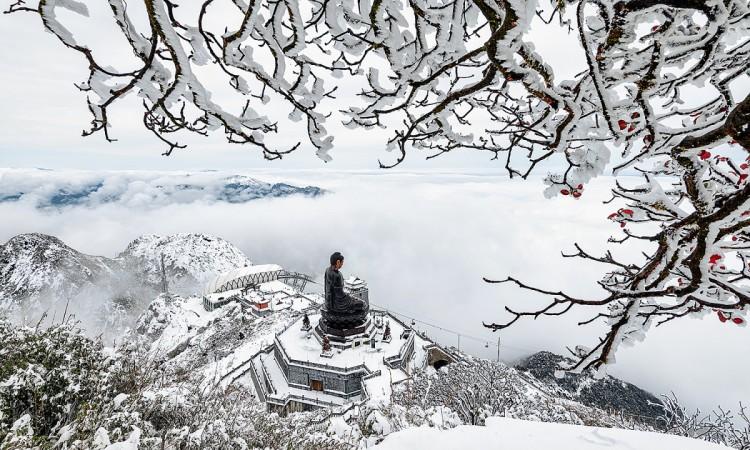
Winter in Sapa - © VnExpress
Cultural Etiquette in Sapa
Understanding and respecting local customs and etiquette is crucial when visiting Sapa, as it helps ensure a positive and respectful experience for both visitors and locals.
Traditional Attire
Many ethnic minorities in Sapa wear distinctive traditional clothing that is often handcrafted and richly embroidered. While it can be tempting to take photos, always ask for permission first, especially if the person is wearing ceremonial attire or performing a ritual. Respecting their personal space and cultural heritage is important.
Giving and Receiving Gifts
Gift-giving is a common practice in Sapa, especially when visiting local families or participating in homestays. Small, thoughtful gifts like sweets, fruits, or simple souvenirs are appreciated. It is respectful to use both hands while presenting or receiving presents. Avoid giving gifts that are too expensive, as this may cause discomfort or embarrassment.
Market Etiquette
Sapa's markets are vibrant places where locals sell handcrafted goods, produce, and other items. When shopping, it's common to haggle over prices, but always do so respectfully. Start by offering a price lower than what you're willing to pay and gradually meet in the middle. Remember that the items are often handmade and the sellers rely on these sales for their livelihood, so be fair in your negotiations.
Respect for Sacred Sites and Traditions
Many villages in Sapa have sacred sites, such as temples, communal houses, and ancestral graves. Always show respect by dressing modestly, speaking softly, and following any posted rules or guidelines. Always get permission before taking photos in places where it may not be allowed. Additionally, unless specifically permitted, avoid touching any buildings or holy items.
Learn more about the cultural etiquette in other regions in northern Vietnam here.
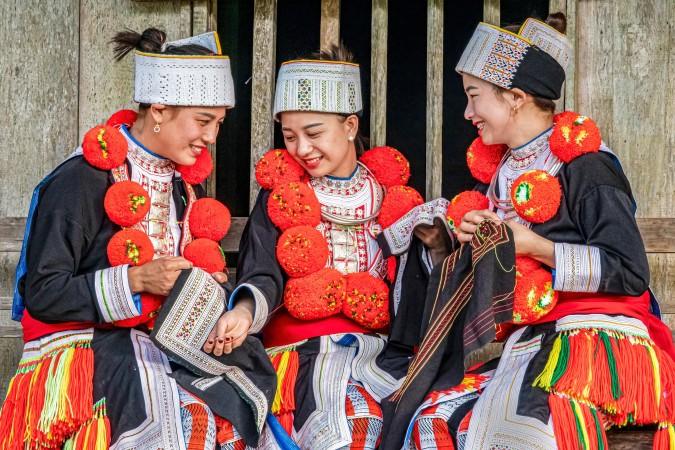
Red Dao people in traditional dress - © Vietnam tourism
Essential Travel Information
Getting Around Sapa
Navigating Sapa and its surrounding areas is relatively straightforward, with several transportation options available to suit different preferences and budgets.
- Motorbike Rentals: Renting a motorbike is a popular and convenient way to explore Sapa and its scenic surroundings. Motorbikes are available for rent in the town center, and they offer the freedom to visit remote villages and attractions at your own pace.
- Local Buses: Local buses and vans operate between Sapa and nearby villages, providing an affordable way to travel. While schedules can be irregular, this option allows you to experience local life and interact with residents.
- Taxis and Private Cars: Taxis and private car services are widely available in Sapa, offering a comfortable and convenient way to travel, especially if you're carrying luggage or traveling with a group.
- Sapa Trekking Tours: Many visitors opt for guided trekking tours, which often include transportation to and from the starting points. These tours are an excellent way to explore Sapa's natural beauty and visit ethnic minority villages with the assistance of knowledgeable local guides.
ATM & Banking Services
Despite being a small town, Sapa provides adequate banking and financial services for travelers. ATMs are conveniently located along main streets and near popular tourist spots, however, it's advisable to carry some cash, as ATMs in remote areas may be scarce or run out of cash during peak tourist seasons. Currency exchange services are available at local banks, hotels, and licensed exchange counters, although exchange rates may not be as favorable as in larger cities.
Where to Stay in Sapa
Sapa provides a diverse range of accommodation options catering to various budgets and preferences. Budget travelers can choose from numerous hostels and guesthouses that offer basic yet comfortable lodging, ideal for backpackers and solo explorers. For those seeking a balance of comfort and cost, mid-range hotels provide modern amenities such as Wi-Fi, hot showers, and on-site dining. Luxury enjoyers can experience high-end resorts with premium facilities, stunning mountain views, and indulgent services like spas and fine dining. Additionally, homestays offer an authentic cultural experience, allowing visitors to live with local families, savor home-cooked meals, and immerse themselves in traditional customs.
Articles for you

Explore Yala National Park - Sri Lanka Travel, Asia
Tucked away in Sri Lanka’s southeastern corner, Yala National Park is where wild nature meets deep tradition. Known worldwide for its leopard population, the park is also home to elephants, sloth bears, crocodiles, and hundreds of bird species. Beyond wildlife, Yala opens doors to a cultural landscape dotted with ancient temples, Buddhist ruins, and coastal villages. For travelers seeking more than just a safari, Yala offers a chance to explore eco-tourism, local communities, and sacred heritage sites.
Population: The Yala National Park area doesn’t have a human population.
Economy: The economy around Yala National Park thrives on a blend of eco-tourism, agriculture, and local services. Safari tours, eco-lodges, and cultural experiences drive steady income for nearby towns like Tissamaharama and Kataragama, supporting thousands of families.
Landmarks: Famous for Block I of Yala and wildlife encounters, including elephants, sloth bears, crocodiles, and exotic bird species.

Explore Galle - Sri Lanka Travel, Asia
Nestled on Sri Lanka’s southern coastline, Galle is a vibrant city where history meets the sea. Its cobbled streets, colonial architecture, and serene beaches make it a must-visit destination for travelers seeking a blend of culture, adventure, and relaxation. A UNESCO World Heritage site, Galle captivates visitors with its Dutch Fort, bustling markets, and friendly locals. Whether you’re exploring the ramparts at sunset or savoring fresh seafood by the shore, Galle promises an unforgettable journey into Sri Lanka’s heritage.
Population: Approximately 113,000 in 2023.
Economy: Galle’s economy thrives on tourism, trade, and fisheries. The city’s historic fort, colonial architecture, and coastal charm draw thousands of international visitors each year, making tourism its main economic driver. Fishing remains vital for local livelihoods, supplying fresh seafood across the region.
Landmarks: Famous for the Galle Fort, Dutch Reformed Church & Maritime Museum, and Unawatuna Beach.

Explore Bentota - Sri Lanka Travel, Asia
Nestled along Sri Lanka’s southwestern coast, Bentota is a tropical paradise that blends golden beaches, vibrant culture, and thrilling adventures. Famous for its calm waters, luxury resorts, and scenic river estuary, Bentota has become a top destination for travelers seeking both relaxation and authentic experiences. From serene beach walks at sunrise to adrenaline-pumping water sports, this coastal town offers a perfect balance of leisure and exploration. With its proximity to Colombo and Galle, Bentota is easy to reach, making it an ideal stop for both short escapes and extended holidays.
Population: Approximately 37,000 in 2023.
Economy: Bentota’s economy thrives mainly on tourism, which drives local businesses such as hotels, restaurants, and wellness retreats. The town also benefits from fishing, coconut cultivation, and handicrafts like wood carving and batik textiles. Many residents rely on the growing demand for water sports and Ayurvedic treatments, making tourism the backbone of both income and employment in the area.
Landmarks: Famous for Bentota Beach, Bentota River Safari, and Kande Vihara Temple.

Explore Mirissa - Sri Lanka Travel, Asia
Mirissa is a charming coastal town on Sri Lanka’s southern shoreline. Known for its golden beaches, turquoise waters, and vibrant marine life, it has become a must-visit stop for travelers exploring the island. Many come for whale watching, surfing, and sunset views at Coconut Tree Hill, but Mirissa offers much more than postcard beauty. The fishing boats you see anchored by the bay carry generations of stories. Local traditions, delicious cuisine, and a laid-back rhythm of life shape every visitor’s experience.
Population: Approximately 4,700 in 2023.
Economy: Mirissa’s economy is largely shaped by its coastal location. Fishing has long been the backbone of local livelihoods, with generations relying on the Indian Ocean for income. In recent decades, tourism has become the main driver of growth, thanks to whale watching, surfing, and beachside hospitality.
Landmarks: Famous for Mirissa Beach, Coconut Tree Hill, and Parrot Rock Bridge.

Explore Nuwara Eliya - Sri Lanka Travel, Asia
Tucked away in the Central Highlands of Sri Lanka, Nuwara Eliya is often called “Little England”. With its rolling tea plantations, cool misty mornings, and colonial charm, this mountain town feels like a step into another world. Travelers come here to breathe fresh air, walk through flower gardens, sip the finest Ceylon Tea, and enjoy a pace of life far from the island’s busy cities. Whether you’re drawn by scenic landscapes, heritage architecture, or the warmth of its people, Nuwara Eliya is a destination that blends nature, culture, and history in perfect harmony.
Population: Approximately 781,000 in 2023.
Economy: Nuwara Eliya’s economy thrives mainly on tea production, as it sits in the heart of Sri Lanka’s central highlands, famous worldwide for Ceylon Tea. The city also benefits from a growing tourism industry, attracting visitors with its colonial charm, cool climate, and scenic landscapes.
Landmarks: Famous for Gregory Lake, Hakgala Botanical Garden, and Victoria Park.

Explore Sukau - Malaysia Travel, Asia
Nestled on the banks of the Kinabatangan River in Sabah, Malaysian Borneo, Sukau is a destination where wildlife, culture, and conservation come together. Known as one of Asia’s top spots for river safaris and eco-tourism, this quiet village offers a front-row seat to encounters with Bornean orangutans, pygmy elephants, proboscis monkeys, and exotic birdlife.
Population: Approximately 1,400 in 2019.
Economy: Sukau’s economy is shaped by its riverine location and natural resources. Traditionally, the Orang Sungai community relied on fishing, small-scale farming, and forest gathering for their livelihood. Today, the village has shifted toward eco-tourism, with river cruises, jungle trekking, and homestays providing income.
Landmarks: Famous for the Kinabatangan River cruises, Gomantong Caves, and Ox-bow lakes and wetlands.
